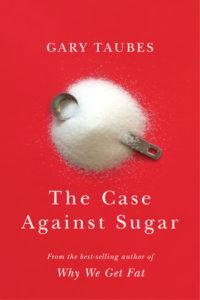 You’ve got to read Gary Taubes’ new book, The Case Against Sugar.
You’ve got to read Gary Taubes’ new book, The Case Against Sugar.
As the title suggests, Taubes’ purpose is
to present the case against sugar – both sucrose and high-fructose corn syrup – as the principal cause of the chronic diseases that are most likely to kill us, or at least accelerate our demise, in the twenty-first century. Its goal is to explain why these sugars are the most likely suspects, and how we arrived at the current situation: a third of all adults are obese, two-thirds overweight, almost one in seven is diabetic, and one in four to five will die of cancer; yet the prime suspects for the dietary trigger of all these conditions have been, until the last decade, treated as little worse than a source of harmless pleasure.
If this were a criminal case, The Case Against Sugar would be the argument for the prosecution.
Though we balk a bit at singling out any one factor as THE difference-maker in the epidemic of chronic disease we face today – there are just too many environmental and lifestyle factors to ignore, not to mention the role of the biological terrain in guiding health and illness – it is incontrovertible that whatever the role sugar plays, it’s a detrimental one.
If you’ve read Taubes’ previous book Good Calories, Bad Calories – or even just some of his long-form essays – you’ll find yourself in familiar territory. Here, though, the focus stays squarely on the single-most problematic ingredient in the Western diet. It may also be familiar from recent news about sugar industry influence on medical and dental research, as well as its attempts to manufacture doubt on current sugar science.
Taubes does an especially good job of tracing a history of bad or misinformed science and political maneuvering that’s enabled our society to become sugar-saturated. This honest look at the scientific evidence makes it plain that the dietary advice we’ve been given through the past decades just plain wrong, resting on “research” that has all too often been outdated or outright tainted.
But there was another thing we appreciated about the book, and that was its highlighting one often unrecognized limitations of medical science in general. One passage in particular is worth quoting at length, as it resonates throughout the book as a whole:
History is critical to understanding science and how it progresses. In many scientific disciplines – physics, for example – the science is taught with the history attached. Students learn not only what is believed to be true and which conjectures have fallen by the wayside, but on the basis of what experiments and what evidence, and by whose authority and ingenuity. The names of the physicists responsible for the advances in understanding – Newton, Einstein, Maxwell (for his equations of electromagnetism); Heisenberg, Planck, and Schrodinger, among others, for their work in understanding the quantum nature of the universe; and many more – are as well known as many historical figures in politics and other fields. Medicine today, though, as with related fields such as nutrition, is taught mostly untethered from history. Students are taught what to believe but not always the evidence on which these beliefs are based, and so oftentimes the beliefs cannot be questioned. And medical students are not taught, as physics students typically are, to question everything that has not demonstrably survived the trial-by-fire process of rigorous, methodical testing. Students of any science need to know why they are being asked to believe a particular idea, or why not, and on what grounds. Without the history of the idea, there’s no way to tell and, by implication, no reason to ask. [emphasis added]
This goes for dentistry, too. It’s why so many young dentists still come out of dental school so sure that mercury amalgam and root canals are “safe,” that mixing metals in the mouth is no problem, and so on. There’s no incentive to question what they’re taught. But there are those who do defy convention – who ask questions, who look at the whole of the evidence, who pursue further education and change their practices accordingly.
While more and more young dentists are choosing this path, still, the far more typical response is to double down on what you already believe and do all you can to believe all the harder. This is one way, Taubes shows, that we got into the mess we have with sugar. So many folks were so sure that “the science” was “settled,” they couldn’t see the errors in their thinking. Taubes includes a wonderful quote from Francis Bacon which nicely illustrates the issue we see in dentistry and medicine (and other arenas) today:
The human understanding, once it has adopted opinions, either because they were already accepted and believed, or because it likes them, draws everything else to support and agree with them. And though it may meet a greater number and weight of contrary instances, it will, with great and harmful prejudice, ignore or condemn or exclude them by introducing some distinction, in order that the authority of those earlier assumptions may remain intact and unharmed.
Sound familiar?